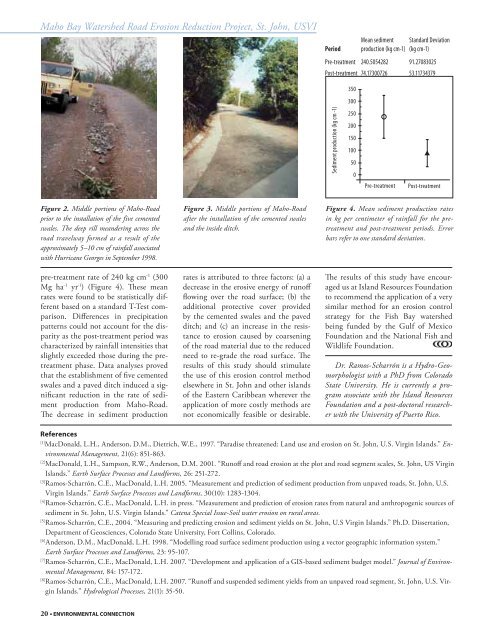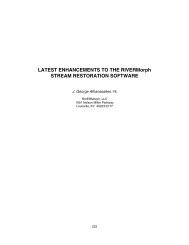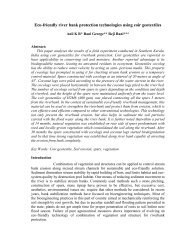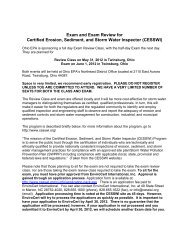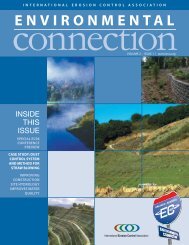ENVIRONMENTAL - International Erosion Control Association
ENVIRONMENTAL - International Erosion Control Association
ENVIRONMENTAL - International Erosion Control Association
Create successful ePaper yourself
Turn your PDF publications into a flip-book with our unique Google optimized e-Paper software.
Maho Bay Watershed Road <strong>Erosion</strong> Reduction Project, St. John, USVI<br />
Mean sediment Standard Deviation<br />
Period production (kg cm-1) (kg cm-1)<br />
Pre-treatment 240.5054282 91.27083025<br />
Post-treatment 74.17300726 53.11734379<br />
350<br />
300<br />
Sediment production (kg cm -1)<br />
250<br />
200<br />
150<br />
100<br />
50<br />
0<br />
Pre-treatment<br />
Post-treatment<br />
Figure 2. Middle portions of Maho-Road<br />
prior to the installation of the five cemented<br />
swales. The deep rill meandering across the<br />
road travelway formed as a result of the<br />
approximately 5–10 cm of rainfall associated<br />
with Hurricane Georges in September 1998.<br />
pre-treatment rate of 240 kg cm -1 (300<br />
Mg ha -1 yr -1 ) (Figure 4). These mean<br />
rates were found to be statistically different<br />
based on a standard T-Test comparison.<br />
Differences in precipitation<br />
patterns could not account for the disparity<br />
as the post-treatment period was<br />
characterized by rainfall intensities that<br />
slightly exceeded those during the pretreatment<br />
phase. Data analyses proved<br />
that the establishment of five cemented<br />
swales and a paved ditch induced a significant<br />
reduction in the rate of sediment<br />
production from Maho-Road.<br />
The decrease in sediment production<br />
Figure 3. Middle portions of Maho-Road<br />
after the installation of the cemented swales<br />
and the inside ditch.<br />
rates is attributed to three factors: (a) a<br />
decrease in the erosive energy of runoff<br />
flowing over the road surface; (b) the<br />
additional protective cover provided<br />
by the cemented swales and the paved<br />
ditch; and (c) an increase in the resistance<br />
to erosion caused by coarsening<br />
of the road material due to the reduced<br />
need to re-grade the road surface. The<br />
results of this study should stimulate<br />
the use of this erosion control method<br />
elsewhere in St. John and other islands<br />
of the Eastern Caribbean wherever the<br />
application of more costly methods are<br />
not economically feasible or desirable.<br />
Figure 4. Mean sediment production rates<br />
in kg per centimeter of rainfall for the pretreatment<br />
and post-treatment periods. Error<br />
bars refer to one standard deviation.<br />
The results of this study have encouraged<br />
us at Island Resources Foundation<br />
to recommend the application of a very<br />
similar method for an erosion control<br />
strategy for the Fish Bay watershed<br />
being funded by the Gulf of Mexico<br />
Foundation and the National Fish and<br />
Wildlife Foundation.<br />
Dr. Ramos-Scharrón is a Hydro-Geomorphologist<br />
with a PhD from Colorado<br />
State University. He is currently a program<br />
associate with the Island Resources<br />
Foundation and a post-doctoral researcher<br />
with the University of Puerto Rico.<br />
References<br />
[1]<br />
MacDonald, L.H., Anderson, D.M., Dietrich, W.E., 1997. “Paradise threatened: Land use and erosion on St. John, U.S. Virgin Islands.” Environmental<br />
Management, 21(6): 851-863.<br />
[2]<br />
MacDonald, L.H., Sampson, R.W., Anderson, D.M. 2001. “Runoff and road erosion at the plot and road segment scales, St. John, US Virgin<br />
Islands.” Earth Surface Processes and Landforms, 26: 251-272.<br />
[3]<br />
Ramos-Scharrón, C.E., MacDonald, L.H. 2005. “Measurement and prediction of sediment production from unpaved roads, St. John, U.S.<br />
Virgin Islands.” Earth Surface Processes and Landforms, 30(10): 1283-1304.<br />
[4]<br />
Ramos-Scharrón, C.E., MacDonald, L.H. in press. “Measurement and prediction of erosion rates from natural and anthropogenic sources of<br />
sediment in St. John, U.S. Virgin Islands.” Catena Special Issue-Soil water erosion on rural areas.<br />
[5]<br />
Ramos-Scharrón, C.E., 2004. “Measuring and predicting erosion and sediment yields on St. John, U.S Virgin Islands.” Ph.D. Dissertation,<br />
Department of Geosciences, Colorado State University, Fort Collins, Colorado.<br />
[6]<br />
Anderson, D.M., MacDonald, L.H. 1998. “Modelling road surface sediment production using a vector geographic information system.”<br />
Earth Surface Processes and Landforms, 23: 95-107.<br />
[7]<br />
Ramos-Scharrón, C.E., MacDonald, L.H. 2007. “Development and application of a GIS-based sediment budget model.” Journal of Environmental<br />
Management, 84: 157-172.<br />
[8]<br />
Ramos-Scharrón, C.E., MacDonald, L.H. 2007. “Runoff and suspended sediment yields from an unpaved road segment, St. John, U.S. Virgin<br />
Islands.” Hydrological Processes, 21(1): 35-50.<br />
20 • <strong>ENVIRONMENTAL</strong> CONNECTION


